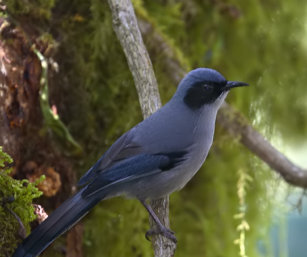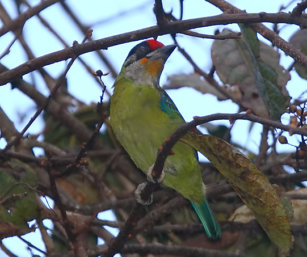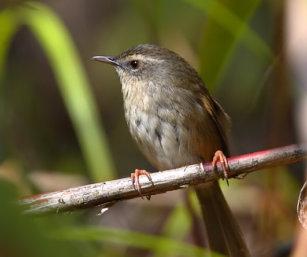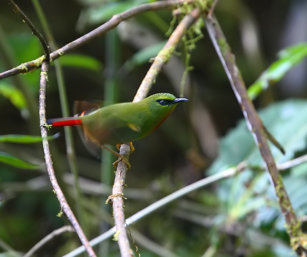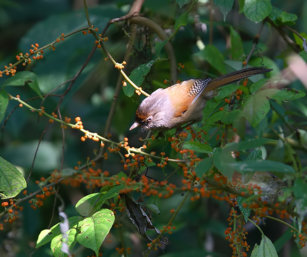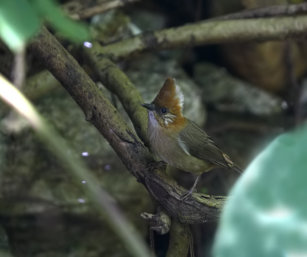Eaglenest, Dec 2006
Birding in magical Arunachal Pradesh!
Tucked away in the western bend of Arunachal Pradesh lies a truly enchanting and magical land. A land of captivating mountains, mesmerizing mist and beguiling wilderness. A land with an inviting name – Eaglenest. So alluring was the name that we decided our very next annual birding trip to the North East had to include Eaglenest Wildlife Sanctuary. That was in December 2005.
There is many a story on how the Sanctuary got it’s name, the most credible is from the Indian Army regiment – Eagle – that was stationed here years ago while trying to make a road to reach the India-China border. Even today, abandoned and ruined military outposts are scattered along this arterial road in the Sanctuary. Eaglenest is a densely packed green expanse of rolling mountains. Our excitement to visit Eaglenest knew no bounds after reading reports of the discovery of a new bird species in this very place. To top it, the person who declared the new bird to Science – Ramana Athreya – had agreed to lead our group!
Ramana Athreya, a radio astrophysicist by profession and ace bird watcher, had spotted this mystery bird way back in 1995. When the bird did not fit any known descriptions in bird guides, his curiosity took him back to Eaglenest in 2004. From then on, Ramana spent substantial time in the cloud forests of Eaglenest and was finally able to uncover the mystery in May 2006. His discovery is a shot in the arm for wildlife lovers and conservationists alike across the world; a candle of hope in the bleak scenario of wilderness protection in India; a proud jewel in the crown of India’s natural heritage. The bird he found was a babbler, almost always skulking in the thick undergrowth in pairs or small flocks. In all, Ramana had seen about 14 birds before he made his discovery public (see detailed paper of the discovery from Indian Birds). He named the new bird Bugun Liocichla (Boo-goon Lee-o-si-kla) after the Bugun tribe of western Arunachal Pradesh.
A very close-knit community with their own village-level Welfare Society, the Buguns are a gentle, hospitable and affectionate lot. In fact, after our very first few interactions with Ramana we realised the immense gratitude and respect he had for the Buguns. He attributes his success of the discovery to the help and support rendered on the field by the Buguns and the other locals. We seemed fairly well-prepared for our trip to Eaglenest by going through various reports of Ramana, about the wilderness, the new bird, the weather, the locales, the community, etc. The formal start of the tour was in Guwahati airport. We were joined by Samir Mehta, an oncologist from Mumbai, and Rahul Kaushik, a designer from Pune. Later, we were joined by two intrepid young naturalists (and Eaglenest veterans) – Shashank Dalvi & Viral Mistry – both from Mumbai. An uneventful yet demanding and cold 6-hour drive from Guwahati, with a quick stop at a roadside dhaba for dinner, took us to Lama Camp, our first destination 10km outside the Eaglenest Wildlife Sanctuary (though there are no borders or gates). Earlier that evening we were introduced to Mr. Indi Glow, the head of the Bugun Welfare Society, who was the key resource in organizing ecotours in this area. A soft spoken, fun-loving yet uncompromising gentleman, Indi Babu as he is locally known, helped us get all our permits even before we set foot into Arunachal Pradesh.
Lama Camp located in the cloud forest zone at an altitude of about 2300m above sea level was a rustic campsite with five mid-sized walk-in tents set up and run by the local community, chiefly consisting of the Bugun tribe. The open-to-sides dining area was closed with synthetic sheets and the fire place – an indigenously built cylindrical contraption with long chimney on one side and a small opening on the other – kept the area warm. We retired for a very cold night!
Next morning we were up at the crack of dawn with no intention of wasting even a single moment of sunlight. Our focus was to photograph the Bugun Liocichla. As we readied ourselves for the day we were astounded to witness a stunning and glorious sight – the sunlit snow-capped peaks of the Arunachal Himalaya. We knew the day was going to be definitely special. And it sure was! Our first attempt to look for the Bugun was right behind the Camp, but after about an hour’s unyielding effort we decided to have breakfast. Post breakfast, we continued to bird along the road from Lama Camp down towards the town of Tenga, where we saw Fire-breasted Flowerpecker, Orange-flanked Bush Robin, Rufous-breasted Bush Robin, Blue-fronted Robin, Golden Bush Robin and many other interesting birds. After having such a wonderful start we decided to head into the Sanctuary in the jeep stopping often whenever we heard or saw mixed flocks of laughing thrushes, yuhinas, barwings and sibias. We were however focused on the Bugun. So, later in the day we stopped at a spot where Ramana had earlier sighted this bird. A few minutes of patience and the use of the bird-call bird produced excellent views of this rarity! An olive-green bird with a flash of red on its tail feathers and sides with yellow spots near its eyes was, the Bugun Liocichla was active and shy in a flock of four. The sighting of this bird and the subsequent satisfactory photograph of it in the wild gave us such a high that we were on cloud nine the rest of the day.
Our next adventure was trekking the trail above Lama Camp, which Ramana fondly calls as the Trago-Panda Route, aptly named so due to his frequent sightings of both the Tragopan (a brilliantly coloured pheasant) and the Red Panda on this route. However, a cloudy day ensured that we returned disappointed with only a sighting of the wren babbler. Our plan for the next day was to reach Bompu Camp about 10km from Lama, set inside the Sanctuary at a slightly lower altitude than Lama.
Bompu was earlier the principal military labour camp, now almost reduced to rubble. The locals have however made the camp liveable by creating shacks ingeniously. Several large tents are also pitched on the flat hill nearby depending on the size of the group. Bompu was extremely productive for us and we were lucky to sight most of our birds below this camp. The routine was to have an early breakfast pack ourselves into the jeep and head along the road with silent prayers for luck! And were we lucky or what! Our sighting one afternoon of the specialties – a pair of Fire-tailed Myzornis and a male Ward’s Trogon back-to-back was proof enough that our prayers were answered! Our bird list is never-ending with over 150 species including Red-faced Liocichla, Rufous-necked Hornbill, Red-billed Leothrix, Silver-eared Mesia, Tesia, Hoary-throated Barwing, Northern Goshawk, and more in just a span of just 5-days!
As we bid adieu to Eaglenest we knew for sure that we would return to this magical land. However, one question loomed large in front of us – how long will this wilderness last? With so little knowledge about this expanse of green and with so little number of people working to protect it, will it last at all? Given what is happening in its foothills in Assam it is a very scary thought.
–swarna













